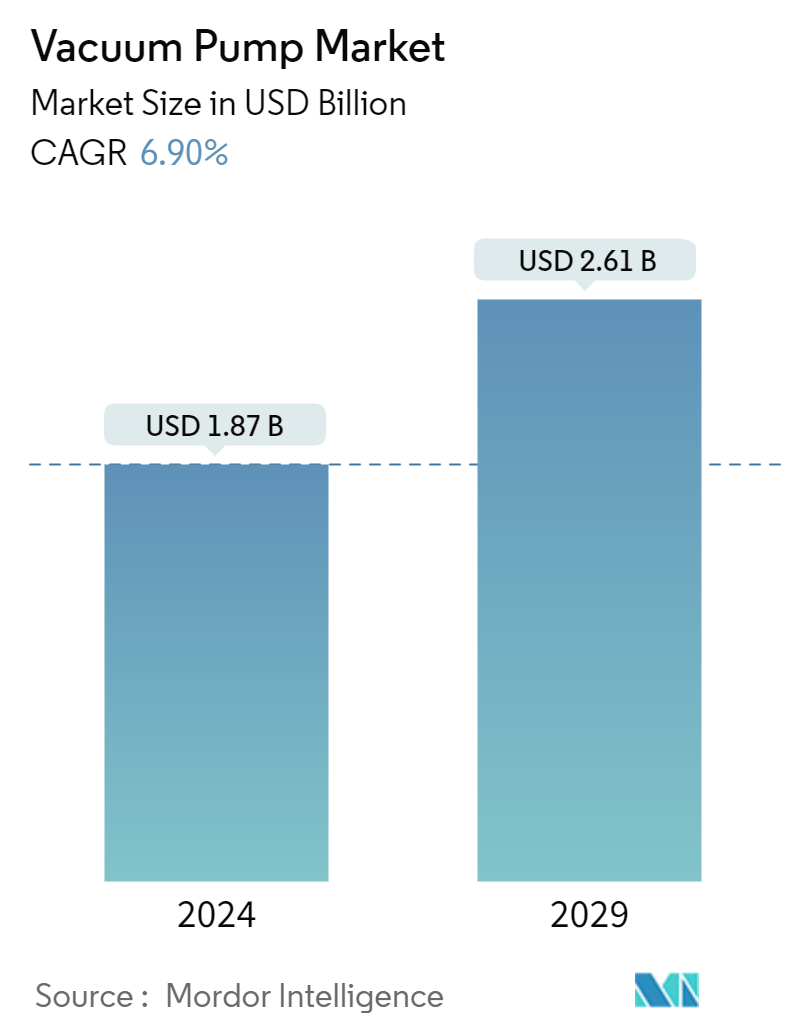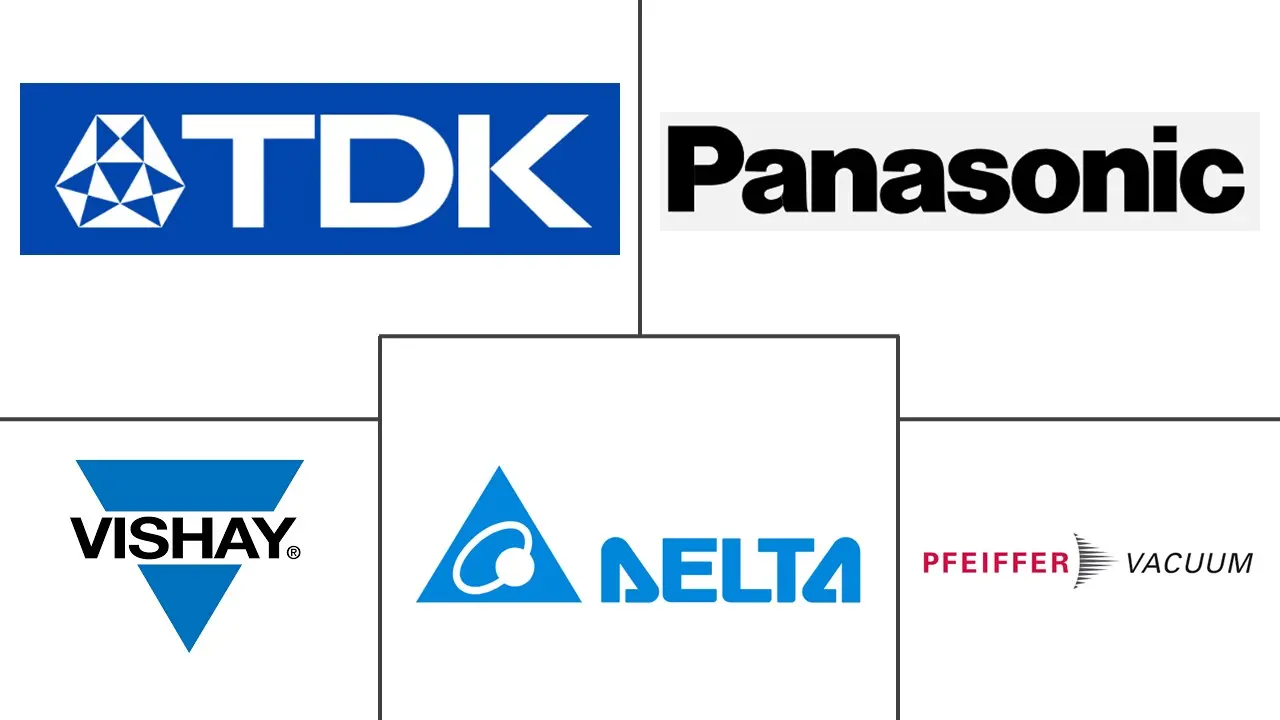Market Size of Vacuum Pump Industry

| Study Period | 2019 - 2029 |
| Base Year For Estimation | 2023 |
| Market Size (2024) | USD 1.87 Billion |
| Market Size (2029) | USD 2.61 Billion |
| CAGR (2024 - 2029) | 6.90 % |
| Market Concentration | Low |
Major Players
*Disclaimer: Major Players sorted in no particular order |
Vacuum Pump Market Analysis
The Vacuum Pump Market size is estimated at USD 1.87 billion in 2024, and is expected to reach USD 2.61 billion by 2029, growing at a CAGR of 6.90% during the forecast period (2024-2029).
The vacuum pump market plays a pivotal role in various industrial applications, enabling processes that require the creation of a vacuum or the efficient removal of gases. This market spans a wide range of pump types, each tailored to meet specific needs across diverse industries, including oil and gas, electronics, medicine, chemical processing, food and beverage, and power generation.
Key Fundamentals
- Diverse Applications: Vacuum pumps are indispensable across numerous industries, each with its own set of unique requirements. In the oil and gas sector, for example, vacuum pumps are crucial for vacuum distillation processes, whereas the electronics industry relies on these pumps for semiconductor manufacturing and MEMS technology. This versatility is a key factor driving the widespread adoption of vacuum pumps in various sectors.
- Technological Advancements: Innovations in vacuum pump technology, such as the development of dry vacuum pumps and advanced kinetic vacuum pumps, have significantly enhanced efficiency, minimized contamination risks, and reduced maintenance costs. These advancements are critical in meeting the growing demands of high-performance industrial applications, ensuring that vacuum pump manufacturers remain at the forefront of technological progress.
- Global Market Dynamics: The vacuum pump market is globally distributed, with significant demand originating from Europe, Asia-Pacific, and North America. Regional variations in industrial growth, technological adoption, and regulatory frameworks influence the market dynamics, shaping the competitive landscape and determining market value. Understanding these dynamics is essential for market participants aiming to navigate the complexities of the global vacuum pump industry.
Porter's Five Forces Analysis
- Bargaining Power of Suppliers: Suppliers of essential components, such as motors and seals, wield moderate power due to the specialized nature of vacuum pump manufacturing. However, large manufacturers often mitigate this by forming strategic partnerships and producing components in-house, reducing dependency on external suppliers.
- Bargaining Power of Consumers: Consumers hold moderate bargaining power, particularly in sectors like electronics and pharmaceuticals, where vacuum pumps are critical. The presence of alternative technologies and multiple suppliers enhances this power, giving consumers leverage in price negotiations and product specifications.
- Threat of New Entrants: The threat of new entrants into the vacuum pump market is low due to the substantial capital investment and technical expertise required. Established players benefit from economies of scale and brand reputation, creating significant barriers to entry for potential newcomers, thereby protecting their market positions.
- Threat of Substitutes: The threat of substitutes is low, as there are few technologies that can match the efficiency and functionality of vacuum pumps in specialized industrial processes. This low threat reinforces the importance of vacuum pumps across various applications, sustaining their demand in the market.
- Intensity of Competitive Rivalry: The competitive rivalry in the vacuum pump market is high, with numerous global players competing on technology, quality, and price. The market is characterized by continuous innovation, with companies constantly seeking to enhance their offerings through strategic mergers and acquisitions, making the competitive landscape dynamic and challenging.
Impact of COVID-19
- Supply Chain Disruptions: The COVID-19 pandemic disrupted global supply chains, temporarily affecting production and distribution in the vacuum pump market. However, the increased demand for vacuum technology in critical applications, such as medical ventilators and pharmaceutical production, provided resilience to the market during this period.
- Acceleration of Digital Technologies: The pandemic also accelerated the adoption of digital technologies and remote maintenance solutions within the vacuum pump industry. These advancements are likely to have a lasting impact, reshaping market dynamics and influencing future growth strategies.
Increasing Demand for Dry Vacuum Pumps
- Contamination-Free Operations: The demand for dry vacuum pumps has risen sharply due to their ability to provide contamination-free operations, which is crucial in industries like electronics and pharmaceuticals. By eliminating the need for oil or water in the pumping chamber, these pumps significantly reduce the risk of process contamination, driving their adoption in environments with stringent cleanliness standards.
- Enhanced Efficiency and Lower Maintenance Costs: Dry vacuum pumps offer superior energy efficiency compared to traditional oil-sealed pumps, resulting in reduced operational costs. Additionally, their design minimizes the need for regular maintenance, further lowering long-term costs for industrial operators. This combination of efficiency and cost-effectiveness is making dry vacuum pumps increasingly attractive to industries aiming to optimize their operations.
- Compliance with Environmental Regulations: With environmental regulations becoming stricter, especially regarding emissions and waste management, dry vacuum pumps, which do not require oil or other contaminants, are gaining preference. Their alignment with these regulations is a significant driver of their adoption across various sectors, reinforcing the importance of sustainable industrial practices.
Increasing Popularity of MEMS Technology
- Rising Applications in Electronics and Automotive Industries: Micro-Electro-Mechanical Systems (MEMS) technology is increasingly popular due to its applications in electronics and automotive industries. Vacuum pumps are essential in MEMS manufacturing, particularly in deposition and etching processes. The growing adoption of MEMS in consumer electronics, automotive sensors, and medical devices is driving the demand for specialized vacuum pumps designed for these applications.
- Advancements in Miniaturization and Precision Engineering: The trend towards miniaturization in electronics has heightened the demand for precision-engineered components, including MEMS devices. Vacuum pumps are crucial in achieving the high precision required in MEMS fabrication. As the demand for smaller, more efficient electronic devices increases, the market for vacuum pumps in MEMS manufacturing is expected to expand significantly.
- Innovation in MEMS Manufacturing Processes: Continuous innovation in MEMS manufacturing processes, including the development of new materials and techniques, is creating opportunities for vacuum pump manufacturers. These innovations necessitate pumps capable of operating under specific conditions, such as ultra-high vacuum environments, further driving demand for advanced vacuum pump technologies tailored to MEMS production.
Vacuum Pump Industry Segmentation
A vacuum pump is an equipment capable of generating a partial or low-pressure vacuum by pushing gas or air molecules out of a sealed chamber. A vacuum is a relative state at which the chamber pressure has a lower pressure than the ambient atmosphere or adjacent systems.
The Europe vacuum pump market is segmented by type (rotary vacuum pumps [rotary vane pumps, screw and claw pumps, and root pumps], reciprocating vacuum pumps [diaphragm pumps and piston pumps], kinetic vacuum pumps [ejector pumps, turbomolecular pumps, and diffusion pumps], dynamic pumps [liquid ring pumps and side channel pumps], and specialized vacuum pumps [getter pumps and cryogenic pumps]), by end-user application (oil and gas, electronics, medicine, chemical processing, food and beverage, and power generation), and by country (United Kingdom, Germany, France, Rest of Europe). The report offers market forecasts and size in value (USD) for all the above segments.
| By Type | |||||
| |||||
| |||||
| |||||
| |||||
|
| By End-user Application | |
| Oil and Gas | |
| Electronics | |
| Medicine | |
| Chemical Processing | |
| Food and Beverage | |
| Power Generation | |
| Other End-user Applications (Wood, Paper and Pulp, etc.) |
| By Country | |
| United Kingdom | |
| Germany | |
| France | |
| Rest of Europe |
Vacuum Pump Market Size Summary
The European vacuum pump market is poised for significant growth, driven by increased investments in new production technologies and capacity expansions across various sectors. The demand for vacuum pumps is particularly strong in industries such as oil and gas, electronics, medicine, chemical processing, and food and beverage. These pumps play a crucial role in fluid systems, waterworks, and food packaging, helping to transport fluids efficiently and extend the shelf life of products by creating airtight seals. The food and beverage industry, in particular, benefits from vacuum pumps in processes like dairy processing, sterilization, and chocolate production, which enhances product quality and reduces waste. Despite disruptions caused by the COVID-19 pandemic, which affected supply chains and led to shortages in countries like the UK, Germany, and France, the market is expected to recover and continue its upward trajectory.
Rotary vane pumps are a key component of the vacuum pump market, widely used in automotive and aviation industries for their ability to facilitate fluid movement in systems such as transmissions and brakes. European vendors, including Atlas Copco, Edwards Vacuum, and Pfeiffer Vacuum GmbH, dominate this segment, leveraging advancements in technology to enhance pump performance and functionality. The market is characterized by intense competition, with companies focusing on research and development to improve speed, control, and application versatility. Recent innovations, such as Atlas Copco's GHS VSD+ series and Pfeiffer Vacuum's multi-stage roots pumps, highlight the industry's commitment to meeting the evolving needs of sectors requiring clean and efficient vacuum solutions. These developments underscore the critical role of vacuum pumps in supporting industrial processes and advancing technological capabilities across Europe.
Vacuum Pump Market Size - Table of Contents
-
1. MARKET INSIGHTS
-
1.1 Market Overview
-
1.2 Industry Attractiveness - Porter's Five Forces Analysis
-
1.2.1 Bargaining Power of Suppliers
-
1.2.2 Bargaining Power of Consumers
-
1.2.3 Threat of New Entrants
-
1.2.4 Threat of Substitutes
-
1.2.5 Intensity of Competitive Rivalry
-
-
1.3 Industry Value Chain Analysis
-
1.4 Impact of COVID-19 on the Vacuum Pump Market
-
-
2. MARKET SEGMENTATION
-
2.1 By Type
-
2.1.1 Rotary Vacuum Pumps
-
2.1.1.1 Rotary Vane Pumps
-
2.1.1.2 Screw and Claw Pumps
-
2.1.1.3 Roots Pumps
-
-
2.1.2 Reciprocating Vacuum Pumps
-
2.1.2.1 Diaphragm Pumps
-
2.1.2.2 Piston Pumps
-
-
2.1.3 Kinetic Vacuum Pumps
-
2.1.3.1 Ejector Pumps
-
2.1.3.2 Turbomolecular Pumps
-
2.1.3.3 Diffusion Pumps
-
-
2.1.4 Dynamic Pumps
-
2.1.4.1 Liquid Ring Pumps
-
2.1.4.2 Side Channel Pumps
-
-
2.1.5 Specialized Vacuum Pumps
-
2.1.5.1 Getter Pumps
-
2.1.5.2 Cryogenic Pumps
-
-
-
2.2 By End-user Application
-
2.2.1 Oil and Gas
-
2.2.2 Electronics
-
2.2.3 Medicine
-
2.2.4 Chemical Processing
-
2.2.5 Food and Beverage
-
2.2.6 Power Generation
-
2.2.7 Other End-user Applications (Wood, Paper and Pulp, etc.)
-
-
2.3 By Country
-
2.3.1 United Kingdom
-
2.3.2 Germany
-
2.3.3 France
-
2.3.4 Rest of Europe
-
-
Vacuum Pump Market Size FAQs
How big is the Vacuum Pump Market?
The Vacuum Pump Market size is expected to reach USD 1.87 billion in 2024 and grow at a CAGR of 6.90% to reach USD 2.61 billion by 2029.
What is the current Vacuum Pump Market size?
In 2024, the Vacuum Pump Market size is expected to reach USD 1.87 billion.

